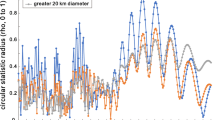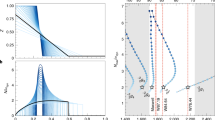Abstract
Observations of Saturn's rings over the last few years have contributed greatly to unravelling questions as to their nature and origin. However, some fundamental issues concerning the vertical structure and thickness of the rings have remained in dispute. In this note we present a synthesis of our results which reconciles most of the conflicting data. We first discuss the vertical structure and show how the many-particle-thick model appears to be feasible, but permits a local ring thickness of only a few tens of metres, much less than the thickness suggested by observations at ring-plane passage. We then describe how solar and satellite perturbations, which are coherent and not dispersive, do not significantly affect the true local vertical thickness of the rings, but do affect the tilt of the mean ring plane in a way that could be relevant to an understanding of the ring-passage observations.
This is a preview of subscription content, access via your institution
Access options
Subscribe to this journal
Receive 51 print issues and online access
$199.00 per year
only $3.90 per issue
Buy this article
- Purchase on Springer Link
- Instant access to full article PDF
Prices may be subject to local taxes which are calculated during checkout
Similar content being viewed by others
References
Focas, J. H. & Dollfus, A. A. Astr. Astrophys. 2, 251 (1969).
Kiladze, R. I. Byull. Abastumani Astrofiz. Obs. 37, 151 (1969).
Lumme, K. & Irivine, W. M. Astr. Astrophys. 71, 123 (1979).
Bobrov, M. S. in Surfaces and Interiors of Planets and Satellites (ed. Dollfus, A.) 377 (Academic, New York, 1970).
Jeffreys, H. Mon. Not. R. astr. Soc. 107, 263 (1947).
Pollack, J. B. Space Sci. Rev. 18, 3 (1975).
Cuzzi, J. N. & Pollack, J. B. Icarus 33, 233 (1978).
Cook, A. F. & Franklin, F. A. Astr. J. 69, 173 (1964).
Brahic, A. Astr. Astrophys. 54, 895 (1977).
Goldreich, P. & Tremaine, S. Icarus 34, 227 (1978).
Franklin, F. A. in The Rings of Saturn (eds Palluconi, F. & Pettengill, G. H.) 178 (NASA SP-343, 1974).
Cuzzi, J. N., Durisen, R. H., Burns, J. A. & Hamill, P. Icarus 38, 54–68 (1979).
Burns, J. A., Hamill, P., Cuzzi, J. N. & Durisen, R. H. Astr. J. (in the press).
Kawata, Y. & Irvine, W. M. in Exploration of the Planetary System (eds Woszczyk, A. & Iwaniszewska, C.) 441 (1974).
Vaaraniemi, P. NASA Publ. N73-19854; Report 14, Aarne Karjalainen Obs.; (Univ. Oulu, Oulu, Finland, 1973).
Bobrov, M. S., Nature 273, 284 (1978).
Harris, A. W. Icarus 24, 190 (1975).
Greenberg, R., Davis, D. R., Hartmann, W. K. & Chapman, C. R. Icarus 30, 769 (1976).
Author information
Authors and Affiliations
Rights and permissions
About this article
Cite this article
Cuzzi, J., Burns, J., Durisen, R. et al. The vertical structure and thickness of Saturn's rings. Nature 281, 202–204 (1979). https://doi.org/10.1038/281202a0
Received:
Accepted:
Published:
Issue Date:
DOI: https://doi.org/10.1038/281202a0
This article is cited by
-
Gravitational wakes in Saturn's rings
Nature (1992)
-
Periodic features in Saturn's F ring: evidence for nearby moonlets
Nature (1990)
-
Dynamics of ring-satellite sytems around saturn and uranus
Celestial Mechanics (1984)
-
Apparent thickness of Saturn's rings
Nature (1981)
-
New progress in the physical studies of the planetary rings
Space Science Reviews (1980)
Comments
By submitting a comment you agree to abide by our Terms and Community Guidelines. If you find something abusive or that does not comply with our terms or guidelines please flag it as inappropriate.



